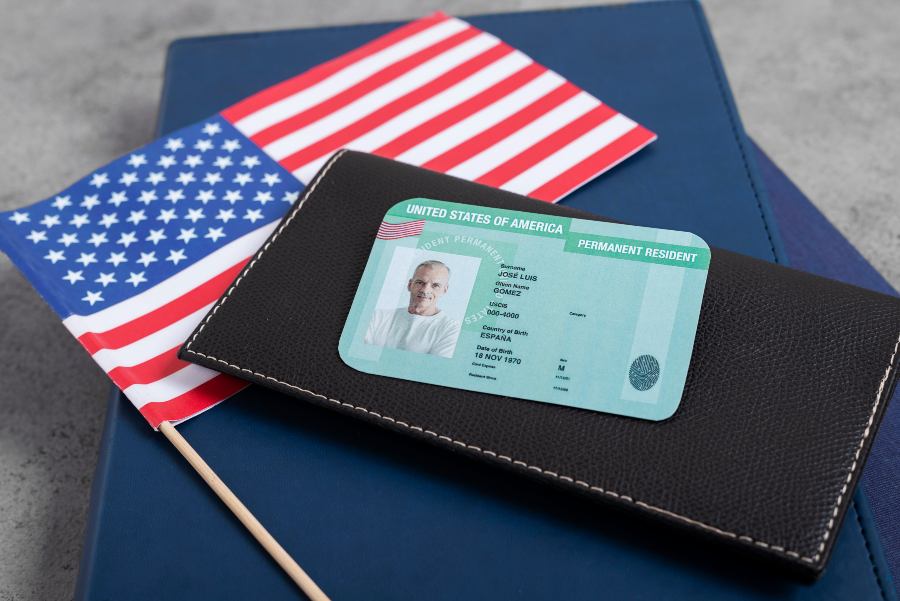If you’re married or in a domestic partnership and trying to replace a conditional green card, you know it’s not as simple as mailing a form and hoping for the best.
Two years might sound short, but when your status depends on it, every day counts.
And it’s not just the timeline. Questions about your relationship, paperwork, or USCIS interviews can make your head spin.
That’s why, in this article, we’ll break it all down: when to file, why domestic partnerships don’t always count, what documents actually matter, how interviews work, and what conditional status really means for couples in the U.S.
1. Processing Timeline Is Extensive
Getting your conditional green card replaced isn’t quick. The I-751 petition to remove conditions takes, on average, almost two years (precisely 21.8 months), but some couples wait as long as 33 months.
That’s almost three years of green card replacement processing time hanging over your head.
The good news, though, is that you don’t just have to sit and wait. There are steps you can take to keep things moving along and avoid unnecessary hoops.
For starters, filing on time. You have a 90-day window before your conditional card expires to file, so make sure not to miss it, or things can get messy.
Also, double-check your documents, and make sure your forms are complete. This can save you months—and a lot of stress.
Oh, and there’s one more silver lining: Once USCIS gets your petition, your conditional status automatically extends while they process your case. But that doesn’t mean you can relax; it just buys you time to get your filing perfect.
2. Domestic Partnerships Do Not Qualify for Green Card Benefits
Under federal immigration law, domestic partnerships and civil unions don’t count as marriage. That means if you’re in a domestic partnership, you cannot sponsor your partner for a green card, no matter what your state says.
Only legally married couples get those marriage-based immigration benefits, and for couples who can’t (or don’t want to) get married, this can feel like hitting a brick wall.
3. Success Rates Are High — But Your Documents Make or Break It
Again with some good news: Marriage-based green card applications generally have high approval rates.
For instance, Form I-130 petitions get approved about 85–90% of the time, and Form I-485 (adjustment of status) approvals often exceed 90%.
Sounds reassuring, right? But don’t get too relaxed. In FY 2024, about 10% of family-based green cards were denied, and the main culprit was insufficient evidence of a genuine marriage or incomplete documentation.
Every missing form, forgotten signature, or unclear piece of proof can turn a nearly guaranteed approval into a long, stressful back-and-forth with USCIS, so having an immigration lawyer by your side to catch these missteps can make all the difference.
4. Interview Waivers Are Possible, But Don’t Count On Them
When you file your I-751 petition, USCIS usually requires an interview, but sometimes they waive it; it’s up to their discretion.
These interviews typically happen 14 to 24 months after filing, so you might have to wait a while before you even know if you’ll have one.
Either way, a well-prepared petition with solid proof of a genuine marriage can increase your chances of skipping the interview entirely.
By the way, if you do get called in, don’t panic. Most interviews last less than 30 minutes and are mainly about verifying that your marriage is real. Think of it as a check-in rather than a grilling session, so just come prepared, and you’ll breeze through it.
5. Conditional Status Applies to Recent Marriages
If you got married two years or less before receiving your green card, you’re issued conditional permanent residence, which is only valid for two years. This applies whether you’re on an immediate relative (IR) visa as a spouse of a U.S. citizen or an F2A visa as a spouse of a permanent resident.
That two-year clock means you’ll need to file Form I-751 to remove the conditions and upgrade to a standard 10-year green card.
Think of it as a temporary ticket that requires follow-up; skip it or delay it, and you could face complications.
William Gall is a seasoned attorney specializing in civil litigation and family law. With a legal career spanning over two decades, William has built a reputation for his meticulous attention to detail and his unwavering commitment to justice. In addition to practicing law, he is a prolific writer, contributing regularly to various legal blogs where he shares his insights on current legal trends, case law, and best practices. His articles are well-regarded in the legal community for their thorough research and practical advice, making complex legal concepts accessible to both legal professionals and the general public.


